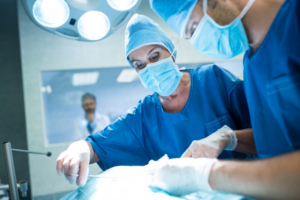Dr.Satish c- Surgical Oncologist in bangalore
Esophageal Cancer Surgery – Esophagectomy
Esophagectomy is the surgical removal of part or complete
esophagus in order to remove the cancerous part from the upper gastrointestinal
tract or restrict the spread of cancer to other parts of the body.

Esophageal Cancer Surgery – Esophagectomy
Overview
Esophagectomy is a complex surgical procedure to remove the cancerous part of the esophagus along with surrounding tissues and associated lymph nodes restricting cancer spread to other parts of the body. In the early stage of esophagus cancer, esophagectomy is the most preferred surgical treatment whereas, in cases of advanced esophageal cancer, esophagectomy is followed by chemotherapy and radiotherapy to destroy any left-out cancerous cells. Depending upon the cancer stage, esophagectomy is done after the chemotherapy and radiation therapy which shrinks the tumour size and eases the removal procedure.

More about Esophagectomy
The esophagectomy surgery involves the removal of the esophagus and the lost part of the esophagus is compensated by reconstructing it with the part of the stomach or colon. The surgery time is approximately 4-6 hours and the patient is discharged after 8 days with an intact feeding tube. The surgery is complex as the surgeon has to reach the causative site by incising the three chambers – neck, chest, and abdomen. The factors influencing the esophagectomy:
- Cancer stage
- Size and location of cancer in the esophagus
- Cancer type (squamous cell cancer or Adenocarcinoma)
- Age and health of the patient
Depending upon the location and stage of the esophagus cancer, the surgeon decides on any one type of esophagectomy surgery to be performed –
- Transhiatal esophagectomy where the main incision is done in the neck and chest region. The cancerous and adjoining normal part of the esophagus is removed and the stomach is pulled to connect to the remaining esophagus.
- Transthoracic esophagectomy where the main incision is done in the chest and abdomen region. This surgery technique is considered only when the tumor is present at the juncture of the esophagus and stomach (gastroesophageal junction). After the removal of cancer affected part of esophagus, a tube is created from the stomach which in turn is connected to the remaining part of the esophagus.
Frequently Asked Questions
The healthcare coordinator will provide a list of instructions to be followed-
- Food: special diet and supplements for maintaining adequate body weight and nutrition value
- Medications: in case the patient is on regular medications for the comorbid conditions, instructions will be given particular those impacting blood clotting
- Submission of documents in case of payment through medical insurance or health cards
Prior to surgery, the patient might be instructed for certain blood tests, and radiological imaging like – Chest X ray and an electrocardiogram (ECG)
The feeding tube will be present until the healing of the created connection (esophagus & stomach) happens which is around 6-8 weeks. A swallow study will be conducted after 3 weeks of the surgery and diet is recommended. Once the patient clears the swallow study, diet transition is recommended accordingly; from clear liquids for 10 days followed by full liquids to soft food.
During the recovery phase, the patient has to follow the instructed special for some time, and later on, the patient can resume his normal food eating. The patient needs to have smaller meals for more frequent times i.e. instead of 3 large meals in a day, the patient needs to have a smaller meal 7 times a day.
Yes. The patient will be on a special diet for maintaining adequate nutrition. The diet will consist of high-protein, and supplements in order to maintain the body weight throughout the treatment course.
The surgery wound healing takes some time. While discharging the wound would have healed superficially and is in process of healing in deeper layers too which takes time – 4-6 weeks. During the recovery phase, the patient is encouraged to undertake physical activities that help in gaining strength and de-stressing like walking for 20-30 minutes 2-3 times a day. The duration and frequency depend completely upon the patient’s health and recovery progress.
Until 8 weeks after the surgery, the patient is advised not to do the following activities –
- Avoid lifting any young age kids or heavy items
- Avoid any strenuous gym or sports activity (jogging etc.)
- Avoid aerobic/Zumba exercises
Any physical activity should be followed by a resting period for recovery.
Patient caretaker should call the hospital staff on an immediate basis if they notice the following things with patient –
- High fever
- Nausea or vomiting
- Any issue with feed tube – clogging/ falls out
- No bowel movement for 3 days or more
- Any leakage from incision wound
- Area or skin around the surgery wound is swelling/becoming more red
- Bad smell from the incision site